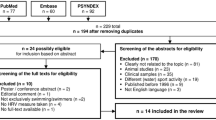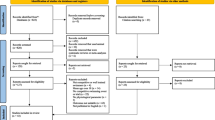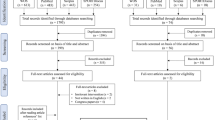Abstract
Background
Swimming is a popular and potentially health-enhancing exercise, but has received less scientific attention compared with other exercise modes.
Objective
The objective of the study was to determine the chronic (long-term) effect of pool swim training on physiological outcomes in non-elite or non-competitive swimming participants.
Design
This study was a systematic review with a meta-analysis.
Data Sources
We searched the electronic databases PubMed, EMBASE and CENTRAL from inception to March 2017.
Eligibility Criteria
The eligibility criteria included randomised controlled trials, quasi-randomised controlled trials and controlled trials of chronic (long-term) swimming interventions in non-elite or non-competitive swimming participants, with a physiological outcome measure.
Results
Our search of 6712 records revealed 29 eligible studies. Swimming had a significant and clinically meaningful effect on maximal oxygen uptake compared with the control in an analysis including multiple populations (mean difference 6.32 mL/kg/min; 95% confidence interval 4.33–8.31), and subgroup analyses of healthy children/adolescents (mean difference 7.93 mL/kg/min; 95% confidence interval 3.31–12.55) and those with asthma (mean difference 9.67 mL/kg/min; 95% confidence interval 5.84–13.51) and healthy adults (mean difference 5.87 mL/kg/min; 95% confidence interval 2.93–8.81). Swimming also resulted in significant improvements in other cardiorespiratory fitness-related outcomes such as maximal minute ventilation (mean difference 0.61 L/min; 95% confidence interval 0.17–1.05), submaximal exercise performance (standardised mean difference 0.64; 95% confidence interval 0.14–1.13) and total exercise test time (mean difference 4.27 min; 95% confidence interval 2.11–6.42). Compared with the control, swimming had significant favourable effects on body mass (mean difference − 2.90 kg, 95% confidence interval − 5.02 to − 0.78), body fat percentage in multiple populations (mean difference − 1.92%; 95% confidence interval − 3.25 to − 0.60) and healthy children/adolescents (mean difference − 1.92%; 95% confidence interval − 4.64 to − 0.80) and lean mass (mean difference 1.96 kg; 95% confidence interval 0.21–3.71), but negative effects on waist circumference in a pooled analysis of two studies involving adults with hypertension (mean difference 4.03 cm; 95% confidence interval 2.58–5.49). Regarding lung function, significant effects of swimming vs. the control were found only for peak expiratory volume in analyses including children/adolescents combined with healthy adults (mean difference 58.74 L/min; 95% confidence interval 29.70–87.78) and children/adolescents with asthma alone (mean difference 63.49 L/min; 95% confidence interval 25.01–101.97). Based on limited data, swimming had similar effects to other exercise modes, except for higher post-intervention body mass index values with swimming vs. running in healthy adults (mean difference 1.18 kg/m2; 95% confidence interval 0.54–1.81).
Conclusions
Swimming may offer robust beneficial effects on cardiorespiratory fitness and body composition across multiple populations and effects may be comparable to other exercise modes. Future randomised controlled trials are required to establish the effectiveness of swimming on physiological outcomes in healthy populations and those with non-communicable disease.




Similar content being viewed by others
References
Chase NL, Sui X, Blair SN. Comparison of the health aspects of swimming with other types of physical activity and sedentary lifestyle habits. Int J Aquat Res Educ. 2008;2:151–61.
Physical Activity Council. Annual tracking sports, fitness and recreation participation in the USA. 2013. http://physicalactivitycouncil.com/. Accessed 6 Sep 2017.
Scheerder J, Vandermeerschen H, Van Tuyckom C, et al. Understanding the game sport participation in Europe: facts, reflections and recommendations. Report SPM10, Sport and Policy Management. 2011.
A.L.S. Sport England, active lives survey, year 1 report. 2016. http://www.sportengland.org/media/11498/active-lives-survey-yr-1-report.pdf. Accessed 6 Sep 2017.
Lazar JM, Khanna N, Chesler R, et al. Swimming and the heart. Int J Cardiol. 2013;168(1):19–26.
Tanaka H. Swimming exercise: impact of aquatic exercise on cardiovascular health. Sports Med. 2009;39(5):377–87.
Aspenes ST, Karlsen T. Exercise-training intervention studies in competitive swimming. Sports Med. 2012;42(6):527–43.
Barbosa TM, Bragada JA, Reis VM, et al. Energetics and biomechanics as determining factors of swimming performance: updating the state of the art. J Sci Med Sport. 2010;13(2):262–9.
Costa MJ, Bragada JA, Mejias JE, et al. Tracking the performance, energetics and biomechanics of international versus national level swimmers during a competitive season. Eur J Appl Physiol. 2012;112(3):811–20.
Cooper LW, Powell AP, Rasch J. Master’s swimming: an example of successful aging in competitive sport. Curr Sports Med Rep. 2007;6(6):392–6.
Ferreira MI, Barbosa TM, Costa MJ, et al. Energetics, biomechanics, and performance in masters’ swimmers: a systematic review. J Strength Cond Res. 2016;30(7):2069–81.
Holmer I. Physiology of swimming man. Exerc Sport Sci Rev. 1979;7:87–123.
Lavoie JM, Montpetit RR. Applied physiology of swimming. Sports Med. 1986;3(3):165–89.
Marino M. Profiling swimmers. Clin Sports Med. 1984;3(1):211–29.
Pendergast DR, Moon RE, Krasney JJ, et al. Human physiology in an aquatic environment. Compr Physiol. 2015;5(4):1705–50.
Toubekis AG, Tokmakidis SP. Metabolic responses at various intensities relative to critical swimming velocity. J Strength Cond Res. 2013;27(6):1731–41.
Troup JP. The physiology and biomechanics of competitive swimming. Clin Sports Med. 1999;18(2):267–85.
Videler JJ, Nolet BA. Costs of swimming measured at optimum speed: scale effects, differences between swimming styles, taxonomic groups and submerged and surface swimming. Comp Biochem Physiol A Comp Physiol. 1990;97(2):91–9.
Koenig J, Jarczok MN, Wasner M, et al. Heart rate variability and swimming. Sports Med. 2014;44(10):1377–91.
Bar-Or O, Inbar O. Swimming and asthma. Benefits and deleterious effects. Sports Med. 1992;14(6):397–405.
Beggs S, Foong YC, Le HC, et al. Swimming training for asthma in children and adolescents aged 18 years and under. Cochrane Database Syst Rev. 2013;(4):CD009607.
Bougault V, Boulet LP. Airway dysfunction in swimmers. Br J Sports Med. 2012;46(6):402–6.
Bougault V, Turmel J, Levesque B, et al. The respiratory health of swimmers. Sports Med. 2009;39(4):295–312.
Fisk MZ, Steigerwald MD, Smoliga JM, et al. Asthma in swimmers: a review of the current literature. Phys Sportsmed. 2010;38(4):28–34.
Geiger KR, Henschke N. Swimming for children and adolescents with asthma. Br J Sports Med. 2015;49(12):835–6.
Rosimini C. Benefits of swim training for children and adolescents with asthma. J Am Acad Nurse Pract. 2003;15(6):247–52.
Bielec G, Peczak-Graczyk A, Waade B. Do swimming exercises induce anthropometric changes in adolescents? Issues Compr Pediatr Nurs. 2013;36(1–2):37–47.
Obert P, Courteix D, Lecoq AM, Guenon P. Effect of long-term intense swimming training on the upper body peak oxygen uptake of prepubertal girls. Eur J Appl Physiol Occup Physiol. 1996;73(1–2):136–43.
Çelik Ö, Salci Y, Ak E, et al. Serum cartilage oligomeric matrix protein accumulation decreases significantly after 12 weeks of running but not swimming and cycling training: a randomised controlled trial. Knee. 2013;20(1):19–25.
Özdemir RA, Çelik Ö, Aşçı FH. Exercise interventions and their effects on physical self-perceptions of male university students. Int J Psychol. 2010;45(3):174–81.
Cox KL, Burke V, Beilin LJ, et al. Blood pressure rise with swimming versus walking in older women: the Sedentary Women Exercise Adherence Trial 2 (SWEAT 2). J Hypertens. 2006;24(2):307–14.
Cox KL, Burke V, Beilin LJ, et al. Short and long-term adherence to swimming and walking programs in older women: the Sedentary Women Exercise Adherence Trial (SWEAT 2). Prev Med. 2008;46(6):511–7.
Cox KL, Burke V, Beilin LJ, et al. A comparison of the effects of swimming and walking on body weight, fat distribution, lipids, glucose, and insulin in older women: the Sedentary Women Exercise Adherence Trial 2. Metabolism. 2010;59(11):1562–73.
Fernández-Luna Á, Gallardo L, Plaza-Carmona M, et al. Respiratory function and changes in lung epithelium biomarkers after a short-training intervention in chlorinated vs. ozone indoor pools. PLoS One. 2013;8(7):e68447.
Lieber DC, Lieber RL, Adams WC. Effects of run-training and swim-training at similar absolute intensities on treadmill VO2max. Med Sci Sports Exerc. 1989;21(6):655–61.
Lu L, Wang Y. Effects of exercises on knee cartilage volume in young healthy adults: a randomized controlled trial. Chin Med J. 2014;127(12):2316–21.
Magel JR, Foglia GF, McArdle WD, et al. Specificity of swim training on maximum oxygen uptake. J Appl Physiol. 1975;38(1):151–5.
Lynch AM, Goodman C, Choy PL, et al. Maternal physiological responses to swimming training during the second trimester of pregnancy. Res Sports Med. 2007;15(1):33–45.
Lynch AM, McDonald S, Magann EF, et al. Effectiveness and safety of a structured swimming program in previously sedentary women during pregnancy. J Matern Fetal Neonatal Med. 2003;14(3):163–9.
Arandelović M, Stanković I, Nikolić M. Swimming and persons with mild persistent asthma. Sci World J. 2007;7:1182–8.
Huang SW, Veiga R, Sila U, et al. The effect of swimming in asthmatic children–participants in a swimming program in the city of Baltimore. J Asthma. 1989;26(2):117–21.
Matsumoto I, Araki H, Tsuda K, et al. Effects of swimming training on aerobic capacity and exercise induced bronchoconstriction in children with bronchial asthma. Thorax. 1999;54(3):196–201.
Varray AL, Mercier JG, Terral CM, et al. Individualized aerobic and high intensity training for asthmatic children in an exercise readaptation program: is training always helpful for better adaptation to exercise? Chest. 1991;99(3):579–86.
Varray AL, Mercier JG, Prefaut CG. Individualized training reduces excessive exercise hyperventilation in asthmatics. Int J Rehabil Res. 1995;18(4):297–312.
Wang JS, Hung WP. The effects of a swimming intervention for children with asthma. Respirology. 2009;14(6):838–42.
Weisgerber MC, Guill M, Weisgerber JM, et al. Benefits of swimming in asthma: effect of a session of swimming lessons on symptoms and PFTs with review of the literature. J Asthma. 2003;40(5):453–64.
Weisgerber M, Webber K, Meurer J, et al. Moderate and vigorous exercise programs in children with asthma: safety, parental satisfaction, and asthma outcomes. Pediatr Pulmonol. 2008;43(12):1175–82.
Wicher IB, Ribeiro MA, Marmo DB, et al. Effects of swimming on spirometric parameters and bronchial hyperresponsiveness in children and adolescents with moderate persistent atopic asthma. J Pediatr. 2010;86(5):384–90.
Edlund LD, French RW, Herbst JJ, et al. Effects of a swimming program on children with cystic fibrosis. Am J Dis Child. 1986;140(1):80–3.
Gappmaier E, Lake W, Nelson AG, et al. Aerobic exercise in water versus walking on land: effects on indices of fat reduction and weight loss of obese women. J Sports Med Phys Fitness. 2006;46(4):564–9.
Gwinup G. Weight loss without dietary restriction: efficacy of different forms of aerobic exercise. Am J Sports Med. 1987;15(3):275–9.
Mohr M, Nordsborg NB, Lindenskov A, et al. High-intensity intermittent swimming improves cardiovascular health status for women with mild hypertension. Biomed Res Int. 2014;2014:728289.
Mohr M, Helge EW, Petersen LF, et al. Effects of soccer vs swim training on bone formation in sedentary middle-aged women. Eur J Appl Physiol. 2015;115(12):2671–9.
Connolly LJ, Nordsborg NB, Nyberg M, et al. Low-volume high-intensity swim training is superior to high-volume low-intensity training in relation to insulin sensitivity and glucose control in inactive middle-aged women. Eur J Appl Physiol. 2016;116(10):1889–97.
Nordsborg NB, Connolly L, Weihe P, et al. Oxidative capacity and glycogen content increase more in arm than leg muscle in sedentary women after intense training. J Appl Physiol (1985). 2015;119(2):116–23.
Silva J, Geraldes A, Natali A, et al. Acute effects of swimming on the arterial pressure of hypertensive adults. Maced J Med Sci. 2009;2(4):330–4.
Nualnim N, Parkhurst K, Dhindsa M, et al. Effects of swimming training on blood pressure and vascular function in adults > 50 years of age. Am J Cardiol. 2012;109(7):1005–10.
Tanaka H, Bassett DR, Howley ET. Effects of swim training on body weight, carbohydrate metabolism, lipid and lipoprotein profile. Clin Physiol. 1997;17(4):347–59.
Tanaka H, Bassett DR, Howley ET, et al. Swimming training lowers the resting blood pressure in individuals with hypertension. J Hypertens. 1997;15(6):651–7.
Alkatan M, Baker JR, Machin DR, et al. Improved function and reduced pain after swimming and cycling training in patients with osteoarthritis. J Rheumatol. 2016;43(3):666–72.
Alkatan M, Machin DR, Baker JR, et al. Effects of swimming and cycling exercise intervention on vascular function in patients with osteoarthritis. Am J Cardiol. 2016;117(1):141–5.
Casey AF, Emes C. The effects of swim training on respiratory aspects of speech production in adolescents with Down syndrome. Adapt Phys Activ Q. 2011;28(4):326–41.
Stephen ATN, Leach AJ, Morris PS. Impact of swimming on chronic suppurative otitis media in Aboriginal children: a randomised controlled trial. Med J Aust. 2013;199(1):51–5.
Higgins JP, Altman DG, Gotzsche PC, et al. The Cochrane Collaboration’s tool for assessing risk of bias in randomised trials. BMJ. 2011;343:d5928.
Stevens J, Truesdale KP, McClain JE, et al. The definition of weight maintenance. Int J Obes. 2006;30(3):391–9.
Myers J, Prakash M, Froelicher V, et al. Exercise capacity and mortality among men referred for exercise testing. N Engl J Med. 2002;346(11):793–801.
DerSimonian R, Laird N. Meta-analysis in clinical trials. Control Clin Trials. 1986;7(3):177–88.
Stransky AW, Mickelson RJ, van Fleet C, et al. Effects of a swimming training regimen on hematological, cardiorespiratory and body composition changes in young females. J Sports Med Phys Fitness. 1979;19(4):347–54.
McAuley L, Pham B, Tugwell P, et al. Does the inclusion of grey literature influence estimates of intervention effectiveness reported in meta-analyses? Lancet. 2000;356(9237):1228–31.
Schmucker CM, Blumle A, Schell LK, et al. Systematic review finds that study data not published in full text articles have unclear impact on meta-analyses results in medical research. PLoS One. 2017;12(4):e0176210.
Altintas D, Cevit O, Ergen N, et al. The effect of swimming training on aerobic capacity and pulmonary functions in children with asthma. Allergy Clin Immunol Int. 2003;1:17.
Acknowledgements
This article arose from work initially commissioned by Prof. Ian Cumming on behalf of the Swimming and Health Commission for Swim England. The authors thank Ann B. Gates, Prof. Ian Cumming and Seven Stones for their help in the original commissioned paper.
Author information
Authors and Affiliations
Contributions
Ian M. Lahart and George S. Metsios contributed to this work by drafting a narrative report after conducting a systematic review of the acute and chronic physiological effects of swimming. The current article includes the systematic review of the chronic physiological effects of swimming together with a meta-analysis of primary and secondary outcomes.
Corresponding author
Ethics declarations
Funding
This work was partly sponsored by the independent Swimming and Health Commission, Swim England, UK.
Conflict of interest
Ian M. Lahart and George S. Metsios have no conflicts of interest directly relevant to the content of this review.
Electronic supplementary material
Below is the link to the electronic supplementary material.
Rights and permissions
About this article
Cite this article
Lahart, I.M., Metsios, G.S. Chronic Physiological Effects of Swim Training Interventions in Non-Elite Swimmers: A Systematic Review and Meta-Analysis. Sports Med 48, 337–359 (2018). https://doi.org/10.1007/s40279-017-0805-0
Published:
Issue Date:
DOI: https://doi.org/10.1007/s40279-017-0805-0




